|
Autumn 1998 (6.3) The Man Who
Loved Too Much by Jean-Pierre Guinhut,
French Ambassador to Azerbaijan
"Leyli and Majnun" is an immortal love story sometimes compared to "Romeo and Juliet" though it predates Shakespeare in oral tradition by more than 1,000 years. Today, it is still one of the most popular epics of the Middle East and Central Asia among Arabs, Turks, Persians, Afghans, Tajiks, Kurds, Indians, Pakistanis, and, of course Azerbaijanis. The story's influence extends
beyond Eastern tradition. If we go back to the Middle Ages at
the time of the troubadours and crusaders of the 11th-13th centuries,
we discover that much of Western courtly literature can be traced
to Oriental literature which, in turn, has influenced more recent
works such as the 13th century German epic by Gottfried von Strassburg
"Tristan und Isolde," the early 13th century French
fable, "Aucassin et Nicolette," as well as William
Shakespeare works of the 16th century and innumerable others. Jean-Pierre Guinhut (pronounced geh-NOO), the French Ambassador to Azerbaijan, is an Orientalist at heart and a connoisseur of Eastern culture and philosophy. A polyglot, he is fluent in Azeri, Turkish, Persian, Arabic, English and French. For the last 30 years, he has both studied as well as worked in diplomacy in Egypt, Qatar, Iran, Libya and now Azerbaijan. His extensive experience and knowledge give him a broad scope that few contemporaries enjoy or can equal. Publishing such an article as Guinhut's in Azerbaijan International is rather unusual for us as it is longer than our usual articles and tends to be more academic in style. However, we found Guinhut's treatment of the topic to be extremely valuable. He not only places the poem in its historical regional context, but also sheds light on its various philosophical interpretations. In the process of preparing this article, the Ambassador supplemented his own reference works with materials he discovered in Baku's Institute of Manuscripts. Some of the miniatures featured on these pages are from treasures found there.
This year, 1998, marks the 90th Jubilee of the first staging of the opera "Leyli and Majnun" by Azerbaijani composer Uzeyir Hajibeyov. Its first performance was staged on January 25, 1908 at the Taghiyev Music Comedy Theater in Baku. It was the first work ever created in the Italian musical genre in the Muslim world. Perhaps, some of you have enjoyed seeing the enactment of "Leyli and Majnun" at the Opera and Ballet Theater in Baku a few nights per year and listening to the talented Alim Gasimov play Majnun. Hajibeyov's version of the story is an enormously successful synthesis between East and West, and between European classical music and Oriental culture. But we ask: What are the origins of this work? Coming from where? And meaning what? To whom? Let me share a few observations and memories about this landmark legend as a former scholar and amateur with the view of giving those of you who liked the play or those who may wish to see it, a hint of its Orientalist luster,
The movie aptly fit all the criteria of the sub-continent's film industry: musical, full of splendor and deeply emotional. When the lovers eventually met at the end and died from the insanity of their love (amour fou), the entire audience, composed mainly of Afghani fierce fighters and Pathan merchants, was sobbing. In fact, the theater was so emotionally charged that I myself wasn't able to hold back the tears. The film was in Urdu. The actors were famous and extremely handsome. And the music - traditional Indian raga - was celestial. You're familiar with the question: "If you were deserted on an island, what dozen books would you want to have with you?" No doubt I would stuff my luggage not only with that Pakistani version of the story but also with another book, inspired by the Leyli-Majnun legend-the French book "Le Fou d'Elsa" (The Madman of Elsa), the Oriental-inspired French divan published in 1963 by Louis Aragon (1897-1982), one of Europe's greatest poets. Aragon's Leyla in real life was Elsa Triolet (born Kagan), a pretty Russian immigrant with an unpredictable, hot temper. Aragon was crazy about her. Influenced by his great passion, he wrote some of France's most famous verses, such as: "Un jour, Elsa, J'ai cru te perdre. Cette agonie, pour moi, n'aura jamais de fin" (Each day, Elsa, I've cried about losing you. That agony, for me, will never have an end). "Le Fou d'Elsa" is a series of poetic reveries set on the eve of the collapse of the Sultan of Boabdil's Granada by pressure from Catholic King Ferdinand and Queen Isabella (1492). The themes and topics of the Bedouin Majnun tradition are revived in these poems and include the period of peaceful friendship between youth, the sudden and absolute love that begins with just a glance, the separation caused by fate brought about by the refusal of the bride's family, the long wait to see one another and the rare occasions where the couple actually met. Another similarity between Aragon's work and the Oriental traditions of courtly love is that the poems are intermingled with poetic prose. Many have been deemed so beautiful that they were set to music. These are modern versions of "Leyli and Majnun." But let's examine some of the origins of the original legend.
In fact, the competitions were so revered that seven of the best poems were hung as national treasures in the place most sacred to Arabia - the Ka'bah, the shrine in the center of the Great Mosque in Mecca. Right: Statue to Nizami in the center of Baku. An elaborate poem by Prince Imru' al Qays is still taught in Arabic literature classes. It begins: "Kifa, nabki, min zikra habibin oua manzili, ala sikkat el'liqua" (My friends, let's stop here and weep, in remembrance of my beloved, on her traces, here at the edge of the dune). The scene is dramatic and the reader (or the listener, as it may be) is at once immersed in an atmosphere of nostalgia and sorrow. The time for love has passed. The beloved will never return, and the lover so carefully portrayed in the poem remains prisoner of his own endless wounded passion, fueled by the evidence of the missing beauty and memories of happier days gone by. But he loves this anguished confinement and cannot stop loving it, sealing an irreversible fate. The story of Leyli and Majnun is of the same tradition. Majnun is left at the crossroads between death and madness. At first he becomes mad and his poetry becomes his salvation. He survives his sorrow because he is living in another realm with his mind wandering amidst poetic symbols. Poetry, in the context of "poesis" of the ancient Greeks, becomes his "creation." And for this reason, he does not die out of pain but stokes it alive, renewing it daily. Trying to ease the pain in the boy's heart, Majnun's father takes him to a sacred temple to ask for God's help. However, instead of praying for relief from his madness, Majnun pleads, "Dear God, for Your own sake and for the sake of love, let my love grow stronger with each passing hour. Love is all I have, all I am, and all I ever want to be!" Without this emotion, Majnun knows his life would be deprived of all meaning.
Left: Scene from Hajibeyov's opera, Leyli and Majnun. Upon his final meeting with his beloved, he no longer wishes to live and cannot prevent his death and so he dies, contented. Leyli dies as well. The conclusion clearly elaborates the death of the lovers, but not the death of love. In some versions of the story, it is Leyli who dies first and then afterwards Majnun. Lying upon her tomb, he passes away, guarded by his only friends, the wild animals. So many art miniatures have been painted depicting this scene from Nizami's lines. They were especially prevalent between the 15th and 17th centuries, inspired by the Miniature Schools of Tabriz, Isfahan, Shiraz, Herat and Bukhara. Today, these paintings can be found in St. Petersburg, Paris, London and Tehran. At least one such original manuscript is kept in Baku at the Institute of Manuscripts. Despite the age of the story, it still has a profound effect on modern audiences, especially youth. Why? Always in the past, love had been a matter of privacy. Union between a couple had been a matter of family diplomacy. The dilemma still causes trauma today, especially for Eastern families who have settled in the United States. Consider Southern California, for example, where 1 million Iranians reside. Many families have been devastated by the existential contradictions between Oriental traditions and the impact of the Western sexual liberation ideology of the 1960s and 70s (See the film: My Beautiful Laundret). For this reason, even up to the contemporary period, in most Oriental countries for any youth or lover who has experienced passionate love the identification or association to Majnun or Leyli is immediate.
This brings us to consider the very nature of Majnun as understood through the ages. First, and foremost, Majnun is a poet and that sets him apart from others. He is able to create a sanctuary within his soul, from which he re-creates his love in the poems he recites. Eventually, his idealized portrait of Leyli differs so much from her real personality that she ceases to be the object of his love. The gaps between the pristine purity of Majnun's feelings and the commonness or "petitesse" of Leyli as an object of his feelings diverges. Right: Miniature: Majnun in the desert among the wild animals, Bukhara (1648). Down through the ages, the Arab, as well as Turk and Persian, memorialists and moralists have written about the trappings of poetic psychology which nourishes its own existence as a substitute for the real experience of love. In this sense, the emotion of love may be no more than a pretext for poetic inspiration. For example in the story when Leyli wants to express her own feelings of love to Majnun, he reproaches her: "Do not speak, for you disturb me from my love for Leyli!" At this point, it is obvious that Majnun has created an idealized portrait of her that is so completely different from her real self that she has stopped being the object of his love. Certainly, Majnun is not a revolutionary character. He removes himself from the social order, despite the fact that he was born into royalty and privilege, and could have profited from his family's wealth. At first, he remains in the city and accepts his new status fatalistically as someone deranged in the eyes of his compatriots. He becomes Majnun (the word means "mad one," possessed by demons or jinn). Never-theless, Majnun still expects his friends to stay with him and deliver his messages and poems to his beloved, but only under the condition that they will not harm her and her clan. He seeks no revenge, neither does he revolt. And last, but not least, Majnun the poet expects his audience to heed his poems and remember him by reciting his verses to others. Note the inseparable union between poetry and music in Arabic, as well as in Persian, Turkic and Urdu traditions that date back as far as history records. The inclination of even the simplest people for classical love poetry, particularly when recited or sung, is obvious. In Arabic poetic tradition, the first verses of poems are devoted to love stories - a tradition which has not changed even up through our modern period. The word for "poem" is called "qassida" and its introductory section is the "nassib." By the way, both words are still in contemporary use in the Azeri language. The nassib was also used by musicians for its own sake in establishing the mood in the introduction. Love poetry became the source of most musical inspiration. To this day, the Orient remains faithful to its traditions. Traditional musicians transmit their artistic knowledge from master to disciple. They rarely play music without singers, and rarely do they sing except classical poetry, mainly love poems. This is the living reality that connects the north Moroccan city of Fez to Kashgar, an oasis city in the Uighur region of western China. Anyone who is interested in this topic can detect it everywhere. The origin of mugam which Hajibeyov used in his interpretation of "Leyli and Majnun" is certainly based on this very ancient tradition. This provides us with an easy transition from the Arabs to the Persians, whose immemorial culture was present in the Arab Jahiliyah period far before Mohammad's revelation. Even the Koran itself is a monument of poetic and epic language, even if it warned of the duplicity of poets and the dangerous fascination of musicians. After the Arab conquest, Iranian music was forced to become secretive and clandestine, and music instruments were reduced in size and were performed only in private circles. Iran The question is: Who won in the end? I'm convinced both Iran and Islam both did. This may explain why the same heritage has been interpreted in different ways between those living in Iran and those from other regions of the Middle East. But the same thing could be said about other decisive religious dogmas. It is certainly true about the interpretation of our legend, "Leyli and Majnun" - Leyli va Majnun (Azeri) or Majnun Leyla (Arabic), or Lili-o Majnun (Persian). Iranians may not have been more religious than Arabs, but they showed an exceptional propensity in mastering Islamic heritage and theology. As we noted before, Persians were present and influential in Mecca far before the time of Prophet Mohammad, of whom Salman-e Pak (Salman, the Pure) was among the closest friends. He was an Iranian Christian. In the Iranian tradition, the character of Majnun has been given the status of a mystical hero. Simply his philosophy was nothing more than striving to draw closer to God on the highest level. Human love served as an initiation to divine love and enabled the believer to reach a level of spirituality, which would bring a normal human being to the very limits of mental coherence. This experience has been described in the most rational terms, first by Plato (The Banquet, The Republic), then by Descartes, himself, who states in his Discours de la Methode, that having reached the limits of reason by practicing systematic doubt, he found himself suddenly close to mental alienation. Even the Koran describes the impact of revelation on Prophet Mohammad's mind, and refers to the accusations of madness directed to him by Mecca's skeptical society with that most appropriate word, "majnun." Another common source of Iranian poets and scholars during the Golden Age of Oriental Philosophie des Lumieres (Ichraq of the 12-13th century) is the ancient Greek philosophical heritage called the Prime Sciences (al-Olum al-Awai'il). One of the major contributions of Plato to humanity is certainly the belief that there are several stages to understanding the nature of man, the world and the divine. Passionate love (ishg) for the beauty of a creature gradually brings lovers to the love of all creatures and the beauty which is vested in them and then to the love of pure beauty, which is the eternal idea of beauty itself. In Islamic terms, this means God himself, because nothing else is eternal and beauty is a part of His Being (al-Jamil). There is a traditional Muslim saying: "God is beautiful and likes beauty." This is one of the pillars of the Iranian perception of Majnun, who is perceived as a mystic. Leyla, therefore, is an instrument of God - woman as a way to God. Women are, like gardens, inseparable from the vision of Paradise. And the belief in a better life, void of deceit, cannot be disassociated from the idea of the temporary nature of life in this world (dunya). Creatures are not forbidden to fulfill their material destiny, whose pleasures and afflictions have to be understood as progressing many steps forward. In this respect the Islamic scriptures include those very human and modern words: "God knows that you cannot help thinking of women." But it is clear for mystics as well as those who are more inclined with secular concerns that there is a gradation between the love of creatures and the love of God himself, the Creator. Those who are called, who are tempted by God and take the risk of becoming God's friends, know that God replies and that His love must prevail above everything else, including human reason. This explains why there are so many names of God that can be translated as epithets of passionate love. (See the Middle Ages Scholastic theory about the divine attributes.) For the mystic, God is loving but He is also jealous and takes revenge at will. But He also listens and always comes back to His friends, whose souls must be both satisfied and satisfying. This sentence has been considered by generations of poets and mystics as the key words of the revelation: "Ya ayyatuha'l nafsu'l mutma'inna, irji'i ila rabbika, raziyatan marziya."(Thou, appeased soul, come back to thy Lord, satisfying and satisfied). One can understand how and why such a strong mystical tradition appeared in the Persian society, after the teachings of Muhyiddin Ibn Arabi ("The greatest Sheikh") and Abu Yazid al Bastami (died 874), and how the society has benefited from this providential drama of Majnun, where Leyli is mainly a reminder of God, and the experience of an impossible love, the regenerating initiation to a heavenly future. Abu Daoud Al-Isfahani, the most famous Oriental analyst of the psychology of love, explains in his book (Kitab Ez-Zahra, The Book of the Rose) that the nature of total love implies that it be kept secret. Once revealed, it becomes a mere fact of life. Moreover, it is dangerous to disclose the longings of love because God would be jealous. A first conclusion against such a background is that poetic love contradicts, in principle, the secret of love, which it violates by publishing it in the middle of the city. Majnun's sin is worse than sexual license because it violates the secret of love (urbiet orbi). Herein lies the very reason why Leyli's family, Leyli's tribe, Leyli's cultural environment reject Majnun the poet - the mad Majnun. He is no longer a human being because of this experience. His public disclosure of his most intimate feelings, which were supposed to be kept secret (until the negotiated decision of the families to marry their children as lovers) has led first to the separation of the couple and the consequential effect on Majnun's reason. But God gives and takes what He wants, and He may even accelerate the course of destiny to those who, intentionally behave against Him and themselves. That is why most interpreters and writers in the Iranian tradition and the Turkic ones as well, view Majnun as a pure and absolute martyr of Divine Love. However, such interpretation is not in the original Arab legend, unless one concludes that the Mecca episode should thus be viewed when Majnun asks God to make His love for Leyli irreversible. Another aspect should be kept in mind in the frame of the Oriental tradition of courtly love, which differs from the Occidental one. In Eastern tradition, the mad love which leads to death and to God, is chaste love. Many traditionalists in the Muslim world have referred to the Islamic tradition which states that separated lovers who die are considered totally purified and go to heaven - platonic idyll. This is not because of Puritanism; on the contrary, it is because the death of virgin lovers is viewed as a major scandal that God would not tolerate without proper retribution against those who had killed them. Western tradition in the Middle Ages is just the opposite. The lovers are not separated and prevented from being together before consummating their love. Separation follows because they have realized their love against society's wishes or against the law. Romeo, Tristan and Lancelot were consumed by their passion. Their ill-fated life is but the consequence of their own behavior. They are punished for their love. As Aragon said on this matter, "En amour, tout interdit." (In love, everything is forbidden.) That simple statement combines both Oriental and Western tradition in one sentence. In the Persian world, the mystic tradition of Majnun gave birth to innumerable works, mainly in the form of "gazals," (love poems on the archetype form of the poet Hafiz) or "akhbar" (recollections on illustrious persons of the past). This form continued between the 9th-12th century. Then comes the period of Nizami. His influence became so wide and so deep that it has influenced all the major thinkers and writers in the Persian language after him. For geographical reasons, we will come back to more discussion about him in the last section of this article - Azerbaijan. At about the time of Nizami, the shape of poetic writing starts to change. It becomes "mathnawi," like Rumi's long epic and narrative poems, comprised of independent verses but characterized by internal rhyme and rhyming of couplets. After Nizami, the most famous poet of the Leyli and Majnun narrative was Jami (1414-1492), a poet of Herat (now Afghanistan) who was initiated into the Nakshbandi Sufi order. His influence on Ottoman literature was immense, especially on Ahmad Sinan Beheshti, who also lived in Herat for awhile. A French translation of his divan was made in 1805 by Chezy. Poets writing in Ottoman and other classical Turkic languages found their inspiration mainly in the Sufi traditions, in Nizami and Jani, as well as Fuzuli. Keep in mind two names: Mir Ali Shir Nava'I (known as the Prince of Poets) and Mohammad Ali Khan (Prince of Khakand) who wrote in Chagatai (Turkmenistan) and died when he was only 20 years old in 1842. Azerbaijan First placed under the authority of the Caliphates of Damascus, then of Baghdad, with numerous Arab Amirs, the region that is actually Azerbaijan today enjoyed, from the beginning, the fresh cultural input brought by the Arab conquest which was incorporated into an ancient Persian heritage. From the 5th century B.C., the Persian Empire's northern border extended to Darband, now in Daghestan. The Seljuk (Turkish) Dynasties and tribes slowly took over from this rich heritage (11th to 14th century A.D.) and became progressively integrated to the Turkic languages area, though remaining under Iranian domain (but, in reality, under uninterrupted Turkish authority) up to 1804 when the Russians took Ganja and to 1823 when the Qajars of Tehran relinquished their rights on the area that is now known as northern Azerbaijan and eastern Armenia. For all these reasons, evidence of the Leyli and Majnun legend so common to the Muslim world, is to be found early in Azerbaijan though mainly in the wake of Persian tradition. The Arab context of the drama was not considered unusual (its nomadic and aristocratic environment being consolidated by the Seljuk experience) and the mystical interpretation was familiar, due to Shi'ite Islam. (Just this summer, Bibi-Heybat's burial place and mosque which is recognized as a holy site, has been restored in Baku. Bibi-Heybat is acknowledged as the daughter of the 7th Imam of Shi'ism). Consequently, Persian education and Turkic sensitivity both gave rise to the two main streams of the Majnun cycle: the Persian treatment by Nizami Ganjavi and the Turkish one by Mohammad Fuzuli. Nizami's legacy is immense as one of the strongest artistic and intellectual personalities of the second half of the 12th century. His works were known in every part of the Oriental world at that time. His "Khamsa" (five poems) includes the love story of "Leyli and Majnun." Nizami was commissioned by the Shirvanshah (Abul-Muzaffar Akhsitan) in 1188 A.D. to write the story; he completed it in 1197. (The Shirvanshah ruled Shirvan and Darband. His capital was first Shemakhi but was moved to Baku from 1234 onwards. The Shirvanshah Palace can be seen inside the ancient Inner City, Ichari Shahar, today and still stands as a landmark of architectural elegance). But Nizami was neither a court poet nor a politician. He was a humanist who described nature with fervor, and human passions with sensuality and perception. He looked at the destiny of mankind with a view to establish universal justice in this world. His facility with the Persian language is extremely sophisticated and as difficult to understand for the average educated reader as is Hafiz' poetry. The 8,000 lines of verse that comprise Nizami's poem "Leyli and Majnun" give a very balanced description of the destiny of the unfortunate lovers, caught between tragic mysticism and their own true feelings and attitudes. Nowhere is real life overpowered by supernatural and cosmic considerations. Every element present in the human soul is kept alive in Nizami's vision, who never tries to evade these contradictions. Fuzuli Fuzuli never hesitated to practice the art of "madah" (apology) and use poetry at the service of his high protectors. This was a sort of cultural necessity. But he was, nonetheless, a major poet of the Azeris and of the Ottomans (whose literary language was much closer to classical Azeri than modern Turkish is now). Three centuries after Nizami, Fuzuli's Leyli and Majnun played for Turkic peoples the same role as Nizami's had for Persian-speakers. It was on the basis of Fuzuli's celebrated poem that Uzeyir Hajibeyov based his opera. Hajibeyov's great contribution to artistic creation j In Azerbaijan, this form of music is known as "mugam." The Arabs call it "maqamat," North Africans say "muashahat" and in ancient Andalusian, a historical region in Southern Spain, it is called "maluf." In Turkey, this musical tradition is called "taksim." To give the expressed feelings a wonderfully emotional tempo, the mugam instrumental music is accompanied by lyrical singing, so common today both in Iran and Kurdish regions, but which seems to have no equivalent in Europe, except in the "cante rondo" of the Gitanos in Spain. In Azerbaijan, mugam is the immemorial tradition of the western part of the country, the mountainous Karabakh, specifically Shusha, the wounded heart of the country where male, female and young boys' voices are equally talented and praised. Thus, in the genius of Hajibeyov, music and poetry were reunited as was the practice in the original Arab poetry. It's just that with Hajibeyov, the larger musical genre takes the shape of an Italian opera, where the orchestra gives floor to traditional instruments which accompany the solo recitatives. This unique blend of symphonic orchestra and mugam first performed in 1908 effectively amplified the strength of the dramatic effects of the story. There are other works inspired
by Leyli and Majnun's legend. In 1947, for example, Gara Garayev
(1918-1982) based a symphonic piece by the same name on Nizami's
model. Though Garayev was considered the best Azerbaijani composer,
the delicacy of this music does not really belong to Oriental
aesthetics, but rather fits with the charm of Gara Garayev's
master, Dmitri Shostakovich. For an eye witness account of the event, see "Leyli and Majnun" - 90th Jubilee, The Opera that Shaped the Music of a Nation by Ramazan Khalilov in AI 5.4, Winter 1997. The new National Music Comedy Theater is now under construction on the exact location of the original Taghiyev Theater. It is scheduled to open soon. Nizami's Voice The future is veiled from our eyes. The threads of each man's fate extend well beyond the boundaries of the visible world. Where they lead, we cannot see. Who can say that today's key will not be tomorrow's lock, or today's lock not tomorrow's key? (page 3) Dearest heart, if I had not given my soul to you, it would have been better to give it up for good, to lose it forever. I am burning in love's fire; I am drowning in the tears of my sorrow. . . I am the moth that flies through the night to flutter around the candle flame. O invisible candle of my soul, do not torture me as I encircle you! You have bewitched me, you have robbed me of my sleep, my reason, my very being. (15) Time passes, but true love remains. The life of this world is, for the most part, nothing but a succession of illusions and deceptions. But true love is real, and the flames which fuel it burn forever, without beginning or end. (31) Every breeze that blows brings your scent to me; Every bird that sings calls out your name to me; Every dream that appears brings your face to me; Every glance at your face has left its trace with me. I am yours, I am yours, whether near or far; Your grief is mine, all mine, wherever you are. (103) In the garden, the leaves were
falling like tears. The flowers had cast off their many-colored
summer gowns and donned the somber robes of autumn. The silver
of the jasmine had lost its luster; the rose wept petals as it
mourned the passing of summer; the narcissus bade its companions
farewell and made ready to depart. . . As the garden slowly withered,
so did Layla: her spring was over, made winter by the freezing
finger of Fate, by the icy touch of life's most trying tribulations.
(243) Back to Index
AI 6.3 (Autumn 1998) |
||||

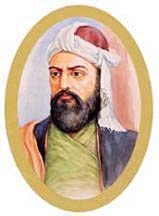
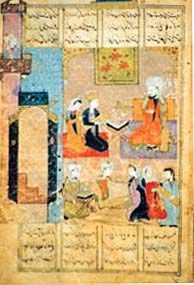
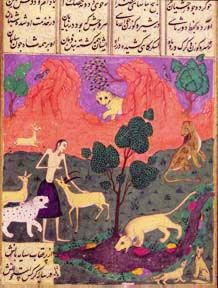
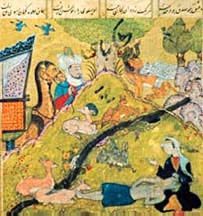
 The Beginning - the Arab Aura
The Beginning - the Arab Aura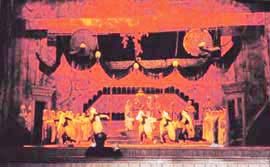
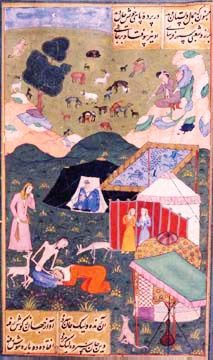 Keep
in mind that the essence of this poetry is still alive enough
to communicate to any gathering of young people a sort of collective
ecstasy, just by listening to this traditional love and court
poetry. The story still affects youth today just as the troubadour
or ashug's song did eight or 10 centuries ago. I myself have
met young Arab lovers who could not face the distress of an impossible
love and ended up dying either by becoming mad or by committing
suicide.
Keep
in mind that the essence of this poetry is still alive enough
to communicate to any gathering of young people a sort of collective
ecstasy, just by listening to this traditional love and court
poetry. The story still affects youth today just as the troubadour
or ashug's song did eight or 10 centuries ago. I myself have
met young Arab lovers who could not face the distress of an impossible
love and ended up dying either by becoming mad or by committing
suicide. For
more about Ambassador Guinhut in his role as French Ambassador,
see our Diplomatic Series earlier this year. AI 6.1, Spring 1998.
This article can also be viewed on the Internet at Azerbaijan
International's Web site: http://azer.com. Click on Topics, then
Diplomatic Interviews.
For
more about Ambassador Guinhut in his role as French Ambassador,
see our Diplomatic Series earlier this year. AI 6.1, Spring 1998.
This article can also be viewed on the Internet at Azerbaijan
International's Web site: http://azer.com. Click on Topics, then
Diplomatic Interviews.